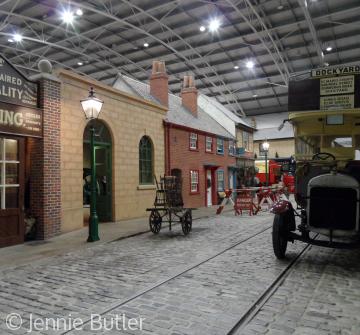Milestones: Hampshire's Living History Museum, Basingstoke

In 1968 Hampshire County Council took possession of the Tasker Collection of traction engines relating to the Waterloo Ironworks in Andover which closed in 1937. During the 1970s they acquired more redundant agricultural machinery, lorries, steam rollers, wagons etc from Hampshire’s industrial past, including Basingstoke manufacturers Thornycroft and Wallis & Steevens. Looking for a suitable site to display the items, HCC and Basingstoke & Deane Borough Council went into partnership and in 1994 made land available at West Ham Leisure Park. Two years later a £6M Heritage Lottery Fund grant enabled the project to start.[1]
A competition was held to name the proposed museum and work commenced in March 1997 by contractors John Sisk & Son Limited. The building is of concrete, aluminium, stainless steel, glass and slate. It is two storeys high but unusually the floors have been sunk 7m into the ground, which involved the removal of 43,000 cubic metres of chalk to create the 102m long arena.[2] The natural insulation provided by the chalk maintains a stable temperature for exhibits and virtually eliminates the need for heating or cooling. The hangar-style roof consists of 17 steel trussed arches of 55m spans. The glazed walls at either end have sealed-in blinds which react to changes in brightness.
Some 21,000 objects in the museum have been laid out in Victorian and 1930s-40s working street scenes, although some household items date back to the early 1700s. Photographic evidence helped to create the façades, and an appeal was made at the beginning of the build for donations of any old bricks, cobbles, slates and tiles as well as street furniture, shop and advertising signs. The Basingstoke Willis Museum Archaeological Group rescued door furniture and fireplaces from houses which were demolished in the late 1960s as part of the town’s redevelopment. Salvage was recycled from Reading bus depot and the demolished Thornycroft factory in Basingstoke; granite kerb stones came from Aberdeen; several hundred feet of unwanted tramrail was purchased from Blackpool and wooden blocks from St Mary’s Gas Works in Southampton.[3] The material was collected by the County’s Museums Services based in Winchester where staff and volunteers collated, cleaned and restored exhibits, finally fitting out the completed buildings in February 2000.
Visitors, aided by costumed guides, can enter fully stocked shops, purchase Milestones Ale in the pub, enter the station booking office and get up close to cars, horse drawn carts and commercial vehicles.
The final cost of the project rose to £11M which was raised by substantial donations from local companies, HCC and B&DBC. The Basingstoke based Sony company donated audio visual equipment.[4] The official opening was carried out by HRH the Duke of Edinburgh on 1st December 2000 with 175,000 visitors in the first year although it has been difficult to maintain this level of interest.[5] In addition to the museum space there is also a restaurant, facilities for school parties and corporate events and an exhibition area. The complex won the Best Social and Industrial Museum of the year award in 2002.[6]
[1] Text based on The Making of Milestones, compiled by Mark Fenton, Hampshire County Council Museums Service, 2000; Hampshire Record Office HPUB/MU1/1/1/3 unless otherwise stated.
[2] Basingstoke Gazette, 8 Jan 1999.
[3] Milestones News, Issue 2, July 1998.
[4] Basingstoke Gazette, 18 June 1999.
[5] Basingstoke Gazette, 23 Nov 2001.
[6] Basingstoke Observer, 29 Aug 2002.
Content derived during research for the new VCH Hampshire volume, Basingstoke and its surroundings.






